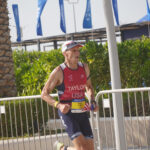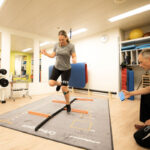Greetings from beautiful Loveland, Colorado, where the air is thin, snow is amazing (kudos to John Hale and his crew!), the nights are cold, and the days are warm and sunny (in other words, ideal conditions for early season skiing). I’m out here this week and again next week working with racers as they put in their first days on snow after an intense period of physical conditioning.
These initial days back on snow after a lengthy time off are key for several reasons. You may feel excitement about the approach of the race season. You begin to experience a sense of urgency to ramp up your skiing. And these first days can set the tone for the rest of this critical prep period leading up to your first races.
I want to devote this article to a discussion of the importance of your first days back on skis after what was likely a fairly long break. I also want to talk about how you can use this period to lay the foundation of mental preparation that will leave you 100% ready to ski your best when you get into the starting gate of your first race.
Let’s identify a few goals for these first days back on snow. First, you want to get comfortable again with your skiing which includes your body, technique, and equipment. This comfort is essential for your building confidence leading up to your first races. You’ll want to start off slowly, focusing on fundamentals, and not try to take any build leaps in your technique or speed. Don’t overthink your skiing at this point, but rather just let your body do what it knows how to do and reestablish a good feeling in your skiing.
Second, use these initial days on snow to identify the key areas you want to work on in the weeks and months leading up to your first races. In other words, what do you need to work on physically, technically, tactically, mentally, or in terms of your equipment? When you have real clarity on these areas in needs of improvement, you’ll be more focused and more efficient in your efforts.
Third, once you’ve gotten your first few days under your belt and you are feeling pretty good on your skis, it’s now time to start experimenting with your skiing to see what works and what doesn’t. You’ll obviously be trying different things out technically, tactically, and with your equipment, but I’m going to focus on how you can experiment mentally to figure out how your head works best.
Mindset
The mindset you have before races sets the stage for how you will ski. In my work with USST athletes and top juniors, I’ve identified two different mindsets (there may be others) that you can adopt to prepare yourself to ski your best.
The first is a calm mindset in which your over-all approach to races is one of quietness and composure. This mindset works best if you ski best in a low-key, low-stress way. To achieve a calm mindset, you must constantly remind yourself to be mellow before races.
The second is an aggressive mindset in which your goal is to be attacking and forceful in races. This mindset works best if you have a tendency to be more passive and reactive than assertive and proactive on course.
Here’s an exercise for you. For two free-ski runs, adopt a calm mindset and see how you feel and ski. For another two free-ski runs, adopt an aggressive mindset and see what happens. Throughout this exercise, look at which is most comfortable and which translates into your best skiing. You can repeat this exercise in gate training as well.
Intensity Style
We are fundamentally physical beings and all the mental preparation won’t help if you’re not physiologically capable of getting down the hill as fast as you can. And ski racing is an explosive sport that requires a certain amount of energy.
Unfortunately, there is no ideal level of intensity for all athletes. You ski your best somewhere between really low intensity (think sleep) and really high intensity (think sheer terror). Your goal is to figure out what your ideal intensity is: low (relaxed), medium (psyched up, but not too much), or high (really fired up). For example, Manfred Pranger is a racer who skis best REALLY intense (check out this YouTube video!).
Here’s an exercise. Take two free-ski runs at really low intensity. Before you begin the runs, take slow, deep breaths and keep your muscles relaxed and your thoughts calm (e.g., “Easy does it.”). During the runs, focus on being really relaxed. Then take two more runs at moderate intensity, focusing on being more amped up. Before the runs, take more forceful breaths, move around a bit more, and think medium-energy thoughts (e.g., “Let’s get it going here.”). During the runs, focus on putting more energy into your skiing. Finally take two more runs at really high intensity. Before the runs, take really aggressive breaths, jump around a lot, and think high-energy thoughts (e.g., “Bring it on!”). You can repeat this exercise in gate training as well.
You may think that a calm mindset and low intensity or an aggressive mindset and high intensity necessarily go together, but that isn’t always the case. In working with one athlete this week, he discovered that he skis best with a more aggressive mindset, but only moderate intensity.
Focus Style
A focus style is a preference for paying attention to certain things. Racers tend to be more comfortable focusing on some things and avoid or don’t pay attention to other things. Every racer has a dominant focus style that impacts all aspects of their ski racing. The two types of focus styles are internal and external.
Racers with an internal focus style ski best when they’re narrowly focused on their ski racing during training or their pre-race preparations. They need to keep their focus narrow, thinking only about their ski racing. These racers tend to be easily distracted by activity in their immediate surroundings, such as other racers, coaches, and course reports.
Racers with an external focus style ski best when they only focus on their ski racing when they’re about to begin a training or race run. At all other times, it is best for them to broaden their focus and take their mind off their ski racing. These racers have a tendency to think too much, become negative and critical, and experience competitive anxiety.
Here’s an exercise for you. Take two free-ski runs. Before the runs, focus entirely on what you want to work on that run. Don’t talk to anyone and keep your eyes down to avoid distractions. Take two more runs. Before the runs, don’t focus on your skiing at all. Talk to people and keep your gaze up. Then, just before you go, narrow your focus on what you want to work on. In both cases, see how well you’re able to stay focused during your runs.
One additional thought about focus style. Some racers who overthink nonetheless believe they ski best with an internal focus style. Because they are thinkers, they are most comfortable thinking a lot before race runs. But their thinking often turns away from the process (i.e., what they need to do to ski well) and onto the outcome (i.e., what result they want, who they want to beat) which hurts their skiing. If you tend to overthink before races, you may be better off using an external focus style because it keeps you from thinking.
If you can figure out the mindset, intensity style, and focus style that works best for you now, you can practice those ideal mental states in the coming weeks and months leading up to your first races. You will see two important benefits from this experimentation. First, the quality of your training will improve because you will be more mentally and physically ready for every training run. Second, you’ll have trained your mind and body to be ideally prepared when you get into the starting gate of your first race. The result? You’re more likely to ski your best and achieve your ski racing goals.






